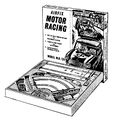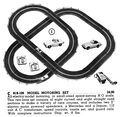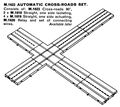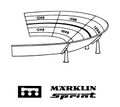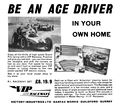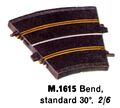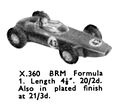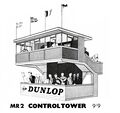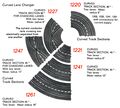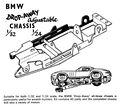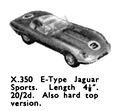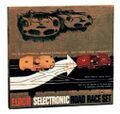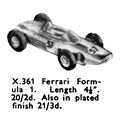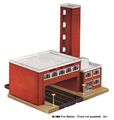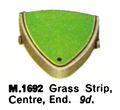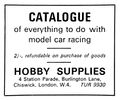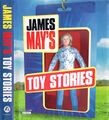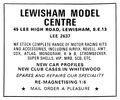Category:Slot car systems
Slot-car systems appeared in the late 1950s, and sales boomed during the 1960s, with the UK market leader being Scalextric. The number of different systems that appeared during this time is in the double digits, and we hope to expand these pages over some months during 2019, to cover most of the main makers.
pre-1950s: "Railed" car racing
Unlike model railways, powered model cars suffered from the problem of how to keep them under control ... even with the advent of affordable radio control after WW2, which was great for model aircraft (which had a huge volume of space to pass through), the precision necessary to race cars on a track wasn't really feasible, especially with the high speeds obtainable with miniature petrol engines. This led to racing on tethers, which limited cars to travelling in a circle (see, e.g., the Jetex rocket-powered toy car), and was only really suitable for speed trials. In the US, some clubs also built large steeply banked tracks for racing that helped cars turn "naturally".
The idea of racing model cars on rail guides is sometimes attributed to a model car club in Birmingham in 1946, who apparently set up a railed track with rubber band-powered cars as a way of keeping younger members amused while the adults worked on "proper" model car business, after which local press coverage made the idea take off. However, it's worth pointing out that Märklin was already selling a commercial railed track system in the 1930s for their clockwork cars.
Mid-1950s
The Portmouth Model Car Club opened a large track in ~1953, egged on by MRRC Ltd, and held a large outdoor meeting in the summer of 1954:
Rail Racing at Portsmouth
THE Portsmouth Model Car Club, who have been holding regular track meetings for the past year, held their first Open Rail Racing Meeting on Sunday, June 20, at the Eastern Road site, Portsmouth. Since the completion of the 168 foot 3-rail track (MM July 1953) numerous modifications have been carried out, the latest being the installation of a lap recording apparatus, which, on its first try-out at this meeting, proved quite satisfactory.
...
— , -, , Model Maker magazine, , September 1954
This seems to have been a very pleasant outdoor event with the large 1:12-scale model-aircraft-engined cars buzzing around the long track and making car-engine noises and car-engine smells.
Model Road Racing Ltd (MRRC Ltd, founded 1951) had also built a circuit in Blackpool, and then opened an improved showcase circuit in Boscombe, Bournemouth, in ~1954 (described in Model Maker Magazine's May 1954 edition) demonstrating the use of concave rollers ("zonkers") on either side of a guide rail, with 1:12 and 1:16 scale cars, fitted with 1.5 cc and 1 cc model aircraft engines, respectively. They also showed an 0.5 cc -engined prototype car using an Albon Dart engine. https://www.slotforum.com/forums/index.php?showtopic=100298&hl=1954
Some in the model motor racing community were alarmed by MRRC's patenting of the roller system, but the company managed to "mend fences" with the community and assured them that they had no intention of using the patent to stunt the growth of the hobby.
Rail Racing Peace
We are happy to announce that the differences existing between Model Road Racing Cars Ltd. and the Model Car Association have been amicably resolved, and that we can now look forward to M.C.A. sponsored national rail racing contests. It would be a very happy gesture if the first such event could take place on Alban Adams' magnificant track at Boscombe.
— , editorial, , Model Maker, , December 1954
In the event, it turned out that the successful version of tracked car racing wouldn't actually use the rail-and-roller system anyway.
1:32, "Tabletop" scale
The next major breakthrough happened with the publication of a December 1954 article on miniature indoor "Table Top Rail Racing" in Model Maker magazine, describing how home builders could produce their own racing car layouts by cannibalising commercial FROG and/or Scalex model cars and fitting them with Mighty Midget electric motors.
Rather than design and build a permanent dedicated layout, the article described how modular foot-wide disassemblable track could be made from a combination of straight, 90-degree and 60-degree curved peg-together sections, with raised wooden guides with wire contacts. This approach radically "lowered the bar" on the amount of effort and commitment needed to build a model racing system, and the risk that it might not work properly. The modular track allowed free-form "flat" layouts for play and reconfiguration into a bridged figure-8 layout for racing (as it made the track lengths the same).
The appearance of slots
Although the layout described in the December 1954 article didn't yet use slots, it brought in almost every other aspect of modern slotcar racing, with a scale of ~1:32 (depending on what was available), and the proof of concept of fitting small motors to commercially-available bodyshells and wheels, and have them scoot around a layout with a physical guide, picking up current from a pair of conductors.
The possibility of racing competitions in the new scale created a desire for standardisation and competition rules, and after a brief period of accelerated development by critical enthusiasts, exchanging information directly, via clubs, and by articles in Model Maker, the final refinement of creating a surface that looked more like a real road by replacing the two conductor raised rail with a two-conductor slot suddenly made the system look like something suitable for commercial mass-market production. A sudden rash of commercial systems then appeared in toyshops, with track-racing pioneer MRRC Ltd teaming up with Airfix to produce the Airfix Road Racing system and MiniModels Ltd. (who'd produced the Scalex model cars that were being hacked about to produce some of the homebrew systems) being bought by Lines Brothers and producing the famous Scalextric system.
Just like model railways, it was now possible to buy a complete ready-to-go system in a box, with clip-together parts, without having to know woodworking or electrical engineering, and slotcar sets became a popular family Christmas present.
Boom and slump
More and more companies climbed on the bandwagon over the next few years, until the hobby seemed to reach a peak some time around ~1966, by which point almost every major toy company one could think of seemed to have their own slotcar system or products.
With vast numbers of systems sold during the "craze" years, the slotcar market then went into a predictable decline, partly since the profusion of different proporietary systems (in the double-digits), and the inevitable withdrawal of some of these makers from an over-populated market led to large numbers of sets mouldering in attics with no obvious way for the average (uncommitted) owner to get spare parts. With model railways, the use of pretty-much standardised 32.5mm 00/H0 track meant that almost any old two-rail system could be got going again with modern components, but with an old slotcar system, an owner who wasn't part of a club might find it more difficult to get back up-and-running again.
Other scales
The US model car racing clubs had already embraced the use of the larger models for tethered speed trials and banked-track racing in a way that didn't really take off in the UK, so some early American slotcar products were built to 1:25 or 1:24 scale. The enthusiasm that shop customers had for playing with store demo layouts also led to a small market for commercial "pay to play" systems. Since these tended to want several parallel lanes to allow visiting groups to race together, the tracks had to be comparatively wide, which meant that large layouts took up more space, which in turn meant that 1:32-sale cars looked out-of scale compared to the track, and were more difficult to see on the more distant parts of a largeish layout. This encouraged a resurgent market for the larger cars, and the US market ended up divided into 1:32 and 1:24-scale, whereas the UK market was mostly 1:32.
The further development of miniature motors allowed a third market: for people who wanted a road system, not necessarily for racing, that would be of a small enough scale to be able to work with an 00 or HO model railway without the sizes jarring too much. Triang's Minic Motorway system was not just size-compatible, the company produced a range of accessories that combined rail and road, including a flatbed loading ramp that allowed one to drive a slotcar up onto the back of a flatbed railway wagon for transportation on the rail network.
External links and resources
- Detailed history of slot cars (review.uk.nf)
- Roedale Model Car Racing Club, Stanmer, Brighton (roedaleslotcars.co.uk)
- Vic Smeed, "Electric Car Racing", Hobbies 1967 Annual pages 12-16.
- OFFICIAL RULES of the Electric Car Racing Association (summary), Hobbies 1967 Annual page 17.
Subcategories
This category has the following 52 subcategories, out of 52 total.
A
- Airfix Motor Racing (14 F)
- AMT slot cars (9 F)
- Aurora AFX (empty)
- Aurora Model Motoring (9 F)
- Auto-Rama (empty)
B
- Beatties Raceways (4 F)
- BMW Models (3 F)
C
- Champion Motor Racing (7 F)
- Circuit 24 cars (4 F)
- Circuit 24 sets (2 F)
- Circuit 24 track (14 F)
- Cox Slot Racers (18 F)
E
- Eldon Road Racing (5 F)
- Electric Highways Model Motoring (1 P, 4 F)
F
- Formula 152 (9 F)
G
K
- K and B (6 F)
M
- Magicar Motoring (1 P, 1 F)
- Marklin Sprint accessories (2 F)
- Marklin Sprint cars (16 F)
- Marklin Sprint sets (6 F)
- Marklin Sprint track (9 F)
- Matchbox Motorway (2 P, 5 F)
- Mighty Midget (4 P, 6 F)
- Minic Motorways Fairground (3 F)
- Minic Motorways miscellaneous (12 F)
- Minic Motorways raceways (3 F)
- Minic Motorways vehicles (25 F)
- Monogram Slot Racers (3 F)
R
- Revell Model Racer slotcars (4 F)
S
- Scale Raceway Models (SRM) (6 F)
- Scalex (1 P, 3 F)
- Scalextric accessories (5 F)
- Scalextric Race-Tuned (3 P, 19 F)
- Scalextric sets (1 F)
- Scalextric track (5 F)
- Superquick MR Series (4 F)
V
- VIP Raceways (11 F)
Pages in category ‘Slot car systems’
The following 18 pages are in this category, out of 18 total.
M
Media in category ‘Slot car systems’
The following 200 files are in this category, out of 407 total.
(previous page) (next page)- 1965 Ford GT, 1-32 Cox kit (BoysLife 1965-06).jpg 1,785 × 2,743; 634 KB
- 90-degree Standard Curve, semi-rigid, Circuit24 track(C24Man ~1963).jpg 1,086 × 449; 71 KB
- A New Game Of Skill, Circuit 24 (C24Man ~1963).jpg 3,000 × 1,885; 769 KB
- AC Cobra Sports, Scalextric Race-Tuned C-78 (Hobbies 1968).jpg 1,484 × 978; 129 KB
- Accessories Make The Track, Scalextric (TriangMag 1965-07).jpg 2,429 × 3,000; 2.03 MB
- Accessory Pack, angle (Matchbox Motorway X1).jpg 1,600 × 1,115; 1.14 MB
- Accessory Pack, box base (Matchbox Motorway X1).jpg 1,600 × 799; 890 KB
- Accessory Pack, box top (Matchbox Motorway X1).jpg 1,600 × 798; 788 KB
- Add Speed, BMW Models chassis, slotcar advert (MM 1966-10).jpg 1,967 × 1,361; 529 KB
- Airfix Motor Racing Set, advert crop (RM 1962-12).jpg 1,889 × 1,338; 937 KB
- Airfix Motor Racing, logo (AirfixMag 1966).jpg 1,200 × 921; 150 KB
- Airfix Motor Racing, MR125 box, lineart (AirfixMag 1966-01).jpg 1,488 × 1,525; 790 KB
- Airfix Motor Racing, set MR11, lineart (Hobbies 1968).jpg 2,730 × 2,001; 1.43 MB
- Airfix MotorAce, logo.jpg 1,729 × 578; 130 KB
- Airfix MRRC racing (AirfixMag 1976-03).jpg 769 × 1,024; 236 KB
- Airfix MRRC, For The Specialist (AirfixMag 1968-04).jpg 802 × 1,024; 325 KB
- Airfix Road Racing, Beatties (AirfixMag 1964-12).jpg 931 × 1,200; 401 KB
- Alfa Romeo 1933 Vintage Road Racer, Scalextric C-65 (Hobbies 1968).jpg 1,375 × 864; 116 KB
- AMT Slot Car Kits (MM 1966-10).jpg 2,287 × 3,000; 2.79 MB
- AMT-Sebring Slot Racing Kits (BoysLife 1965-08).jpg 3,000 × 2,277; 1,013 KB
- Aston Martin DB4 GT, Minic Motorways M1573 (TriangRailways 1964).jpg 1,793 × 885; 568 KB
- Aston Martin GT, Scalextric C-68 (Hobbies 1968).jpg 1,635 × 963; 150 KB
- Aston Martin, Circuit 24 slotcar (C24Man ~1963).jpg 1,812 × 1,047; 454 KB
- Aurora Double-Eight Racing Layout (Schwarz 1966).jpg 3,000 × 1,380; 1.32 MB
- Aurora Model Motoring chassis (MM 1966-10).jpg 3,000 × 2,076; 2.58 MB
- Aurora Model Motoring logo (1965).jpg 570 × 216; 52 KB
- Aurora Model Motoring Set (Schwarz 1962).jpg 2,467 × 2,403; 1.54 MB
- Aurora Model Motoring, Figure-Eight (Schwarz 1966).jpg 2,457 × 1,560; 1.03 MB
- Aurora racing, logo (1963).jpg 800 × 215; 69 KB
- Austin A40, Minic Motorways M1557 (TriangRailways 1964).jpg 1,390 × 877; 444 KB
- Austin Healey 3000 Sports, Scalextric C-74 (Hobbies 1968).jpg 1,525 × 939; 130 KB
- Austin Healey Sports, Race-Tuned Scalextric C-93 (Hobbies 1968).jpg 1,485 × 865; 122 KB
- Austin Mini-Cooper, Scalextric C-76 (Hobbies 1968).jpg 1,272 × 953; 118 KB
- Authentic Model Turnpike (AMT), logo (1962).jpg 1,257 × 654; 132 KB
- Authentic Model Turnpike slot car system (Schwarz 1962).jpg 3,000 × 1,860; 1.64 MB
- Authentic Model Turnpike, AMT, box (Schwarz 1962).jpg 1,690 × 1,172; 603 KB
- Auto-Models Ltd, slotcar advert (MM 1966-10).jpg 1,536 × 1,258; 312 KB
- Automatic Cross-Roads Set, Minic Motorways M1623 (TriangRailways 1964).jpg 2,000 × 1,778; 905 KB
- Banked Curve Supports, Marklin Sprint 1546 (Marklin 1971).jpg 1,548 × 1,153; 607 KB
- Banked Curves 45-degrees, Marklin Sprint 1248 1268 (Marklin 1971).jpg 1,543 × 1,234; 592 KB
- Banked Curves, Marklin Sprint (Marklin 1971).jpg 1,631 × 1,457; 268 KB
- Banking and Bridging, Scalextric (ScalextricCat 1960-01).jpg 3,000 × 1,831; 2.73 MB
- Batmobile, K and B, Aurora (MM 1966-10).jpg 3,000 × 1,405; 1.74 MB
- Be An Ace Driver, VIP Raceways (MM 1961-12).jpg 2,961 × 2,613; 2.08 MB
- Be In The Lead With Cox, slotcar range, advert (MM 1966-10).jpg 2,324 × 3,000; 2.47 MB
- Beatties Motor Racing Catalogue 1966, Scalextric lineart (MM 1966-10).jpg 941 × 1,312; 516 KB
- Beatties of London, new Southgate branch (MM 1966-10).jpg 2,182 × 2,673; 2.39 MB
- Beatties Raceways (MM 1966-10).jpg 1,168 × 3,000; 1.6 MB
- Beatties Raceways Supertracks (MM 1966-10).jpg 1,237 × 1,600; 498 KB
- Bedford Lorry with Bale Load, Minic Motorways M1546 (TriangRailways 1964).jpg 1,800 × 1,079; 802 KB
- Bend, Outer, 45deg, Minic Motorways M1616 (TriangRailways 1964).jpg 1,772 × 915; 504 KB
- Bend, Single Track, 45deg, Minic Motorways M1617 (TriangRailways 1964).jpg 1,280 × 677; 278 KB
- Bend, Standard 30deg, Minic Motorways M1615 (TriangRailways 1964).jpg 768 × 688; 195 KB
- Bend, Standard, 45deg, Minic Motorways M1613 (TriangRailways 1964).jpg 1,077 × 706; 275 KB
- Bend, Standard, 90deg, Minic Motorways M1611 (TriangRailways 1964).jpg 1,748 × 789; 470 KB
- Bentley 1929 Vintage Road Racer, Scalextric C-64 (Hobbies 1968).jpg 1,368 × 853; 117 KB
- BMW Models, advert (MM 1966-10).jpg 3,000 × 1,939; 2.2 MB
- Bobcat Motor for slotcars, K and B (MM 1966-10).jpg 2,293 × 1,377; 1.62 MB
- Breakdown Lorry, Minic Motorways M1565 (TriangRailways 1964).jpg 1,617 × 1,189; 663 KB
- BRM Formula 1 Car, Playcraft X360 (MM 1966-10).jpg 802 × 695; 140 KB
- BRM Formula 1 slotcar kit, 1-24 scale, Cox 9200 (Hobbies 1967).jpg 1,600 × 1,144; 311 KB
- BRM Formula 1, Scalextric C-85 (Hobbies 1968).jpg 1,347 × 819; 95 KB
- BRM Grand Prix, Scalextric Race-Tuned C-89 (Hobbies 1968).jpg 1,398 × 847; 108 KB
- BRM Racecar, Cox (MM 1966-10).jpg 3,000 × 2,075; 2.23 MB
- BRM, 1-24 Cox kit (BoysLife 1965-06).jpg 1,849 × 1,514; 369 KB
- Bugatti 1934 Vintage Grand Prix, Scalextric Race-Tuned C-95 (Hobbies 1968).jpg 1,575 × 913; 122 KB
- Build That Big Layout With Playcraft Railways (ModelRailways3e 1962).jpg 1,997 × 3,000; 2.06 MB
- Bungalow with automatic garage, Minic Motorways M1806 M1807 (TriangRailways 1964).jpg 2,000 × 1,442; 1.03 MB
- Bus Garage, Minic Motorways M1803 (TriangRailways 1964).jpg 2,000 × 1,543; 1.51 MB
- Car Transporter, Minic Motorways M1548 (TriangRailways 1964).jpg 1,946 × 1,425; 1.04 MB
- Car Water Ferry Loading Quay, Minic Motorways M1579 (TriangRailways 1964).jpg 2,000 × 1,118; 791 KB
- Car Water Ferry Set, Minic Motorways M1580 (TriangRailways 1964).jpg 1,982 × 804; 512 KB
- Car Water Ferry, Minic Motorways M1578 (TriangRailways 1964).jpg 1,933 × 1,046; 621 KB
- Caravan, Minic Motorways M1553 (TriangRailways 1964).jpg 1,277 × 953; 482 KB
- Catalogue cover, Scalextric (Scalextric31 1990).jpg 1,149 × 1,600; 273 KB
- Champion Motor Racing, logo, Playcraft (MM 1966-10).jpg 2,765 × 922; 294 KB
- Champion Motor Racing, Playcraft (MM 1966-10).jpg 2,216 × 3,000; 2.32 MB
- Chaparral 2E Sports Car, Marklin Sprint 1315 (Marklin 1973).jpg 1,900 × 900; 697 KB
- Checkpoint Bravo Rally Set, Minic Rally Racing (MM 1966-12).jpg 1,209 × 1,600; 312 KB
- Chicane, Circuit 24 track (C24Man ~1963).jpg 1,073 × 408; 54 KB
- Chicane, Marklin Sprint 1216 (Marklin 1971).jpg 1,605 × 809; 419 KB
- Circuit 24 logo (1962).jpg 800 × 479; 51 KB
- Circuit 24 manual, rear cover (C24Man ~1963).jpg 3,000 × 1,876; 871 KB
- Circuit 24 sets (MCat ~1963).jpg 1,600 × 1,117; 242 KB
- Circuit 24 slotcar system (MM 1962-12).jpg 2,394 × 3,000; 1.47 MB
- Circuit24 Le Mans in Miniature (MCat ~1963).jpg 2,200 × 763; 369 KB
- Coach, Minic Motorways M1544 (TriangRailways 1964).jpg 1,869 × 1,016; 796 KB
- Conqueror Tank, Minic Motorways M1569 (TriangRailways 1964).jpg 1,797 × 974; 607 KB
- Control Tower and Timekeepers Stands, Superquick MR4 (KKH ~1969).jpg 3,000 × 2,158; 1.55 MB
- Control Tower, Superquick MR2 (KKH ~1969).jpg 3,000 × 2,833; 2.34 MB
- Controller, Scalextric A-256 (Hobbies 1968).jpg 1,571 × 775; 97 KB
- Cooper Formula 1, Scalextric C-81 (Hobbies 1968).jpg 1,435 × 860; 99 KB
- Cooper Grand Prix, Scalextric Race-Tuned C-88 (Hobbies 1968).jpg 1,384 × 840; 99 KB
- Couplings, Circuit 24 track (C24Man ~1963).jpg 867 × 503; 44 KB
- Cox Hobbies (BoysLife 1965-08).jpg 2,358 × 3,000; 1.28 MB
- Cox precision-scale racing (BoysLife 1965-06).jpg 3,000 × 1,696; 1.42 MB
- Cross-Roads, 90deg, Minic Motorways M1623 (TriangRailways 1964).jpg 1,303 × 1,066; 489 KB
- Curved Track Sections, Marklin Sprint (Marklin 1971).jpg 2,925 × 2,625; 2.23 MB
- D Type Jaguar, Competition, Scalextric Race-Tuned C-91 (Hobbies 1968).jpg 1,484 × 921; 122 KB
- Developing a Circuit, Scalextric (Scalextric31 1990).jpg 1,145 × 1,600; 350 KB
- Diecast Magnesium Chassis, Cox Hobbies (BoysLife 1965-08).jpg 1,361 × 813; 128 KB
- Double Decker Bus, Minic Motorways M1545 (TriangRailways 1964).jpg 1,716 × 1,281; 1,009 KB
- Double Straight, Standard, Minic Motorways M1609 (TriangRailways 1964).jpg 2,261 × 1,165; 711 KB
- Double-8 Racing Layout, box, Aurora Model Motoring (1965).jpg 1,250 × 904; 210 KB
- Drive SRM 1-40 scale Grand Prix slotcars (MM 1966-10).jpg 1,233 × 1,600; 820 KB
- Drop-Away brass chassis for slotscars, BMW Models (MM 1966-10).jpg 2,329 × 2,066; 1.08 MB
- E-type Jaguar Sports Car, Playcraft X350 (MM 1966-10).jpg 751 × 695; 135 KB
- E-Type Jaguar, Minic Motorways M1559 (TriangRailways 1964).jpg 1,701 × 952; 514 KB
- Eldon Deluxe Road Race Set, box, lowres (1963).jpg 485 × 366; 129 KB
- Eldon Road Racing, logo (1963).jpg 800 × 292; 60 KB
- Eldon Selectronic Road Race Set, box, lowres (1963).jpg 508 × 482; 169 KB
- Electric Highways Model Motoring, logo.jpg 1,140 × 580; 72 KB
- Extension Set, box lid (Matchbox Motorway E2).jpg 1,200 × 762; 671 KB
- Ferrari Formula 1 Car, Playcraft X361 (MM 1966-10).jpg 730 × 695; 133 KB
- Ferrari Grand Prix, Scalextric Race-Tuned C-90 (Hobbies 1968).jpg 1,343 × 808; 97 KB
- Ferrari GT, Scalextric C-69 (Hobbies 1968).jpg 1,467 × 869; 125 KB
- Ferrari Supersqualo Formula Racing Car, Marklin Sprint 1301 (Marklin 1973).jpg 1,900 × 900; 571 KB
- Ferrari V8 racecar, Super Shells (MM 1966-10).jpg 3,000 × 1,864; 2.24 MB
- Ferrari, 1-24 Cox kit (BoysLife 1965-06).jpg 2,128 × 1,683; 411 KB
- Filling Station, Minic Motorways M1801 (TriangRailways 1964).jpg 2,000 × 1,111; 980 KB
- Fire Engine with Flashing Light, Minic Motorways M1550 (TriangRailways 1964).jpg 1,618 × 977; 700 KB
- Fire Station, Minic Motorways M1804 (TriangRailways 1964).jpg 1,899 × 2,000; 1.38 MB
- Ford Grand Touring, Scalextric Race-Tuned C-77 (Hobbies 1968).jpg 1,475 × 903; 113 KB
- Ford GT Roadster, Revell 1-24 scale (MM 1966-10).jpg 2,289 × 1,721; 1.51 MB
- Ford GT, 1-24 scale, Cox (BoysLife 1965-11).jpg 1,200 × 747; 210 KB
- Ford GT, 1-32 slotcar, box, AMT (BoysLife 1965-08).jpg 2,200 × 1,574; 710 KB
- Formula 1 BRM racing car, Airfix Clubman range (MM 1966-10).jpg 1,475 × 2,000; 1.59 MB
- Formula 152 layout (MM 1966-10).jpg 3,000 × 1,302; 1.08 MB
- Formula 152 patent, figure 1 (GB844436 1960-08).jpg 898 × 644; 113 KB
- Formula 152 patent, figure 2 (GB844436 1960-08).jpg 1,180 × 673; 139 KB
- Get Scalextric - Its the Best (TriangMag 1965-05).jpg 2,315 × 3,000; 1.53 MB
- Get Scalextric - Its the Best(TriangMag 1965-03).jpg 2,243 × 3,000; 2.4 MB
- Get Scalextric - Its the Best(TriangMag 1965-04).jpg 2,282 × 3,000; 1.79 MB
- Go Motor Racing With Minic (MM 1965-10).jpg 1,220 × 1,600; 396 KB
- Go-Kart Racing Game, Circuit 24 (MM 1963-10).jpg 2,204 × 2,832; 943 KB
- Go-Kart, Circuit 24 slotcar (C24Man ~1963).jpg 1,802 × 1,437; 414 KB
- Go-Kart, Scalextric K-1 (Hobbies 1968).jpg 1,021 × 845; 73 KB
- Goodyear and Dunlop Racing Tyres, Cox Hobbies (BoysLife 1965-08).jpg 1,141 × 825; 114 KB
- Gradient Base, Minic Motorways M1628 (TriangRailways 1964).jpg 1,438 × 800; 412 KB
- Gradient Base, Single Track, Minic Motorways M1635 (TriangRailways 1964).jpg 1,274 × 544; 270 KB
- Gradient Summit, Minic Motorways M1629 (TriangRailways 1964).jpg 1,428 × 724; 412 KB
- Gradient Summit, Single Track, Minic Motorways M1636 (TriangRailways 1964).jpg 1,364 × 541; 298 KB
- Gran Turismo slotcar set, Revell (MM 1966-10).jpg 3,000 × 1,447; 1.81 MB
- Grass Strip, Centre, Straight, Minic Motorways M1690 (TriangRailways 1964).jpg 1,341 × 652; 338 KB
- H A Blunt slotcar advert (MM 1966-10).jpg 1,600 × 1,053; 477 KB
- Half Flyover, Circuit24 track (C24Man ~1963).jpg 1,145 × 525; 64 KB
- Half Staight - flexible, Circuit 24 track (C24Man ~1963).jpg 704 × 389; 37 KB
- Half Straight, Minic Motorways M1602 (TriangRailways 1964).jpg 973 × 747; 241 KB
- Hand Controller for Race-Tuned cars, Scalextric A-262 (Hobbies 1968).jpg 1,571 × 1,107; 130 KB
- Highways Model Motoring, logo (~1962).jpg 1,800 × 900; 326 KB
- Hobby Supplies, slotcar advert (MM 1966-10).jpg 1,561 × 1,301; 354 KB
- Humber Super Snipe, Minic Motorways M1543 (TriangRailways 1964).jpg 1,720 × 972; 525 KB
- Hump Back Bridge Summit, Minic Motorways M1627 (TriangRailways 1964).jpg 1,435 × 737; 441 KB
- Humpback Bridge, Scalextric advert (MM 1961-02).jpg 2,461 × 3,000; 1.01 MB
- Hurricane Combination, Scalextric B-2 (Hobbies 1968).jpg 1,153 × 774; 81 KB
- Inclines, Marklin Sprint 1290 1291 (Marklin 1971).jpg 1,618 × 1,094; 611 KB
- Jaguar 3point4, Minic Motorways M1542 (TriangRailways 1964).jpg 1,560 × 868; 479 KB
- Jaguar E-type Sports Car, Marklin Sprint 1308 (Marklin 1973).jpg 1,900 × 900; 615 KB
- Jaguar, Circuit 24 slotcar (C24Man ~1963).jpg 1,748 × 1,056; 448 KB
- James Mays Toy Stories, cover and spine (ISBN 9781844861071).jpg 1,451 × 1,600; 1.39 MB
- Jim Hall Chaparral slotcar kit, 1-24 scale, Cox 1400 (Hobbies 1967).jpg 1,600 × 998; 295 KB
- Jim Hall Chapparal, 1-24 scale, Cox (BoysLife 1965-11).jpg 1,200 × 755; 219 KB
- John W Bagnall, slotcar advert (MM 1966-10).jpg 1,527 × 662; 269 KB
- Junction Y, 30deg, Minic Motorways M1630 (TriangRailways 1964).jpg 1,486 × 973; 498 KB
- Junction, Left, 90deg, Minic Motorways M1626 (TriangRailways 1964).jpg 1,447 × 1,111; 473 KB
- Junction, Left, Lay-By, Minic Motorways M1633 (TriangRailways 1964).jpg 1,425 × 973; 438 KB
- Junction, Right, 90deg, Minic Motorways M1624 (TriangRailways 1964).jpg 1,718 × 1,005; 524 KB
- Junction, Right, Lay-By, Minic Motorways M1632 (TriangRailways 1964).jpg 1,747 × 852; 507 KB
- Just Like The Real Thing, Airfix Motor Racing (AirfixMag 1966-01).jpg 919 × 1,200; 645 KB
- Just Like The Real Thing, Airfix Motor Racing (MM 1964-09).jpg 908 × 1,200; 642 KB
- Just Like The Real Thing, Airfix Motor Racing (MM 1966-10).jpg 2,380 × 3,000; 3.71 MB
- K and B Aurora, logo (1965).jpg 400 × 258; 37 KB
- K and B slotcars (MM 1966-10).jpg 2,126 × 3,000; 2.53 MB
- Lane Change graphic, Wrenn Formula 152 (RM 1962-12).jpg 917 × 608; 185 KB
- Le Mans by Lebrayne, front cover of the Circuit 24 manual (C24Man ~1963).jpg 3,000 × 1,885; 1.1 MB
- Le Mans Club Slotcar Circuit, Circuit 24 (C24Man ~1963).jpg 3,000 × 1,947; 371 KB
- Lewisham Model Centre, slotcar advert (MM 1966-10).jpg 1,532 × 1,274; 464 KB
- Lola T 222 Racing Car, Marklin Sprint 1320 (Marklin 1973).jpg 1,900 × 900; 620 KB
- Lorry with Container Load, Minic Motorways M1547 (TriangRailways 1964).jpg 1,966 × 1,206; 841 KB
- Lotus 30 1-32 slotcar, box, AMT (BoysLife 1965-08).jpg 2,200 × 1,565; 682 KB
- Lotus Formula 1, Scalextric C-82 (Hobbies 1968).jpg 1,303 × 807; 95 KB
- Lotus Grand Prix, Scalextric C-54 (Hobbies 1968).jpg 1,375 × 859; 113 KB
- Lotus Indianapolis, VIP Raceways (MM 1966-10).jpg 3,000 × 2,006; 2.3 MB
















